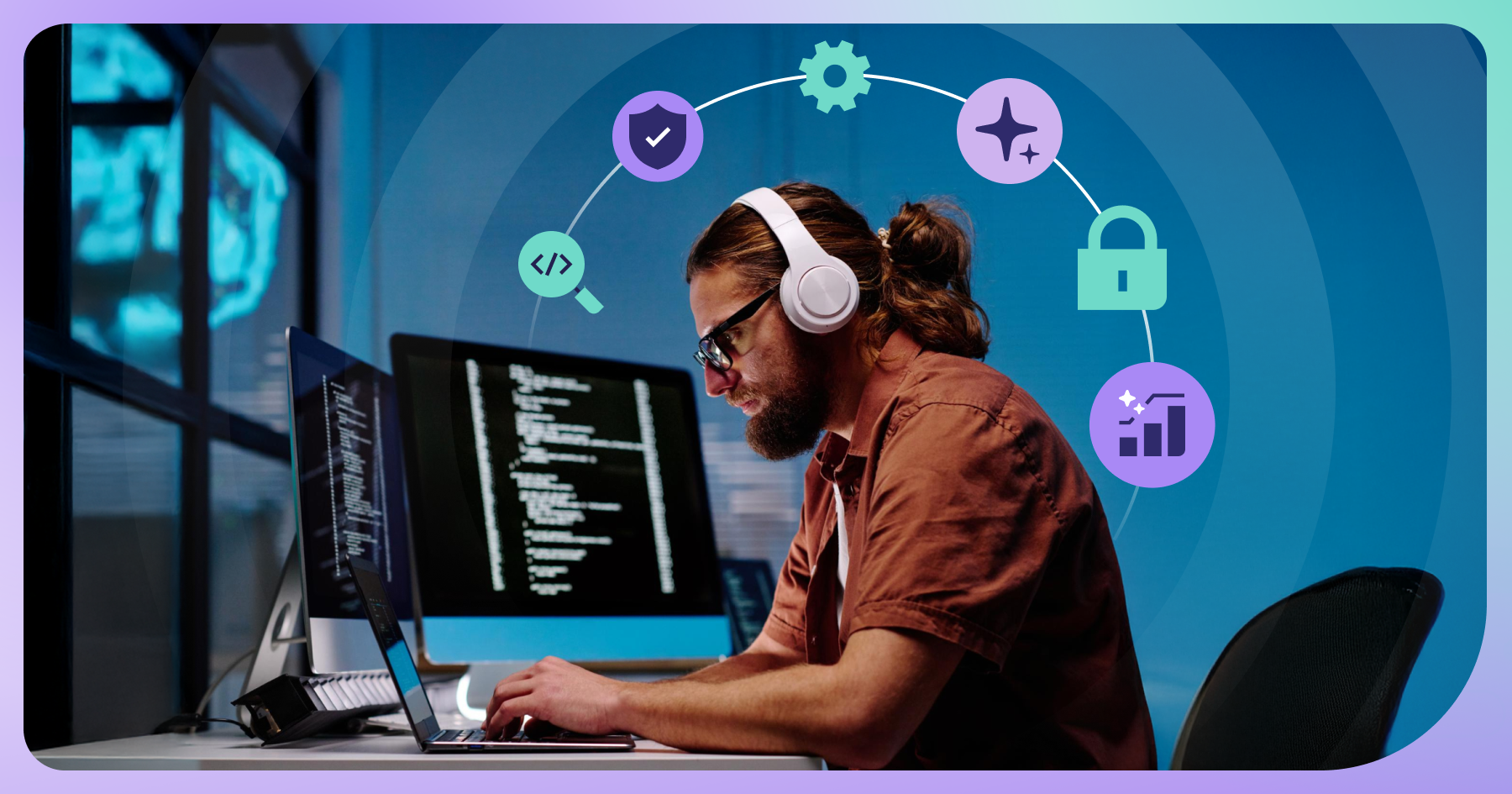Consider the barrage of notifications your development team receives every day. Emails, Slack notifications, meetings, issue updates, Jira boards, and more - across multiple projects at the same time - constantly redirect developers’ attention. On average, developers are interrupted 13 times per hour.
Never-ending context switching is draining your team’s productivity, breaking their concentration and making it much more challenging to finish tasks at hand - increasing the rate of errors, slowing down time-to-market, and leading to employee burnout.
Many teams look to AI to solve productivity issues. However, if your challenges stem from context switching, you'll have to get to the root of the problem in order to get the most out of AI. Let’s dive deeper into the state of context switching among DevSecOps teams, strategies to reduce context switching, and how you can thoughtfully introduce AI to accelerate your teams’ workflows.
The costs of context switching
Context switching has a tremendous impact on a developer’s daily experience, influencing productivity, security, and project deadlines.
Less productivity and more errors: Developers spend only 20 seconds to 2 minutes on activities (such as writing code or running tests) before switching to another. This fragmentation leads to poorer code quality and more errors as developers cannot complete a task before a notification or required review breaks their concentration.
High rate of burnout: Context switching also negatively impacts job satisfaction. According to a study by the University of Irvine, after only 20 minutes of interrupted tasks, people reported significantly higher stress, frustration, and pressure. With such a wide variety of interruptions, it can feel overwhelming to accomplish a single task. Over time, these frustrations can lead to employee burnout.
Common causes of context switching
While some causes of context switching are more challenging to identify than others, understanding the underlying issues can help teams adjust their workflows.
Complex toolchains
Toolchains that include multiple point solutions as part of a single development workflow often complicate the development process. Consider a development team working on a deployment pipeline with multiple manual steps and approvals that each occur in a different tool. When teams work with many disparate tools, they hop not only between projects, but between multiple systems and interfaces just to complete basic tasks - one tool for code review, another for CI/CD, another for security scans, and another for deployment. This slows teams down as they navigate the software development lifecycle (SDLC).
Unfortunately, working across a complex toolchain is the standard, not the exception. GitLab’s 2024 Global DevSecOps report found that 42% of respondents use 6-10 tools in their development tech stack, while 20% use over 11 tools.
Meeting and notification overload
Beyond process and tooling challenges, developers face constant real-time interruptions. A company culture that is overly dependent on meetings can hinder productivity. Similarly, notifications such as Slack and email constantly draw attention away from a project, especially if employees feel pressured to respond immediately.
How engineering leaders can reduce context switching
You aren’t powerless in the battle against context switching. In fact, you can take several steps to minimize context switching across your organization.
Understand your team’s context switching patterns
Start by investigating where context switching occurs within your team. You can leverage:
- Self-reporting methods, such as surveys, questionnaires, and regular check-ins to get an anecdotal understanding of the amount of context switching that occurs.
- Digital tracking tools like Toggl, RescueTime, or Clockify to track time spent on different tasks and identify task switching patterns.
- Productivity analytics through a DevSecOps platform like GitLab to pinpoint what issues are taking the longest and where workflows need to be streamlined.
Once you understand your team's patterns, here are key areas where you can reduce context switching:
1. Simplify your toolchain
Use the data you gathered to consider how to best address context switching. Before jumping to AI as the productivity fix-all, take inventory of the tools currently being used by your teams. By understanding what tools are redundant, what can be consolidated, and where systems can be centralized, you’ll reduce the number of platforms developers use daily before adding on AI as another tool.
GitLab’s report on Navigating AI Maturity in DevSecOps found that respondents using AI for software development were more likely to want to consolidate their toolchain than those not using AI tools. Interestingly, there wasn’t a significant difference in the number of tools each group used, which shows that AI may add to the context switching problem if it isn’t thoughtfully integrated.
2. Address cultural factors
If your teams are overwhelmed by meetings, notifications, or other internal commitments, there are several strategies you can put in place to increase focus time and reduce context switching.
- Create meeting-free days: Designate one day each week when no meetings should be scheduled to allow for high-context, focused work.
- Time-block meetings: Meetings typically require less concentration than project work. Tell your team to reserve their best focus hours for project work (for example, some people work better in the morning, others in the afternoon).
- Alternate who attends meetings: Divide and conquer meetings across the team. This can give junior members more exposure and spread out the time each team member spends in meetings.
- Cancel meetings without a clear agenda: Empower your team to ask for agendas before the meeting. Team members can then determine whether or not the meeting is relevant to their work.
- Set notifications to “do not disturb”: Encourage team members to block time on their calendars for heads-down focus work. This includes setting statuses on applications like Slack or Discord to “do not disturb” to reduce interruptions.
By increasing quality focus time you can improve productivity, reduce stress, and create a happier work environment. Once you have done everything you can to simplify the toolchain and reduce internal disruptions, consider adding AI to further address bottlenecks across the SDLC.
3. Thoughtfully incorporate AI into workflows
When you’re ready to add AI to your workflow, start with one designated AI tool, and run a pilot with a select group of team members. You can identify use cases that inform the tool’s effectiveness and performance, and receive feedback from the team on ease of use and overall value before fully integrating the tool into your systems. The key is ensuring any AI tools are integrated into existing workflows rather than becoming another source of context switching themselves.
Here are a few ways teams can integrate AI to increase productivity:
Leverage an AI chatbot within a DevSecOps platform: Developers can ask questions about documentation without leaving the IDE or platform where they’re writing or deploying code. In this way, AI helps teams improve productivity and time-savings while decreasing the cognitive load associated with context switching.
Receive AI explanations of code: Developers can learn what a block of code does and why it behaves a certain way without leaving the platform. This can be especially useful when team members are trying to understand portions of code written by others.
Explain vulnerabilities with AI: When DevSecOps teams identify security flaws, they often spend hours determining the root cause with manual troubleshooting. Using AI, developers can receive vulnerability explanations that automatically generate relevant information about the vulnerability, provide resolution suggestions, and recommend code to fix it.
Solving context switching
While reducing context switching looks different for every company and team, it often requires restructuring your toolchain, evaluating developer workflows, and reducing notifications and meetings.
Once you understand the elements contributing to your team’s productivity and workflow, you can intentionally incorporate AI to streamline manual tasks and improve efficiencies.
Next steps
How to get started using AI in software development
Learn how to strategically implement AI to boost efficiency, security, and reduce context switching. Empower every member of your team with AI capabilities.
Download the guideLearn how to strategically implement AI to boost efficiency, security, and reduce context switching. Empower every member of your team with AI capabilities.
Frequently asked questions
Key takeaways
- Context switching is known as the killer of productivity, leading to increased error rates and slowing down development velocity.
- Context switching is caused by overcomplicated workflows and complex toolchains — systems that AI cannot solve alone.
- AI can support developers in reducing context switching if it is thoughtfully integrated into development workflows.

